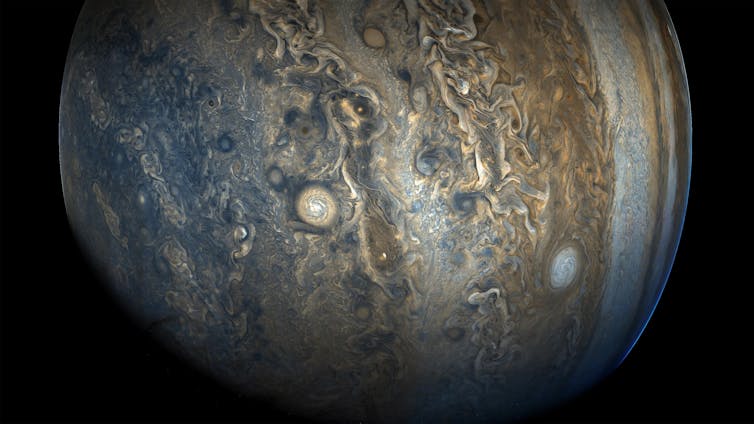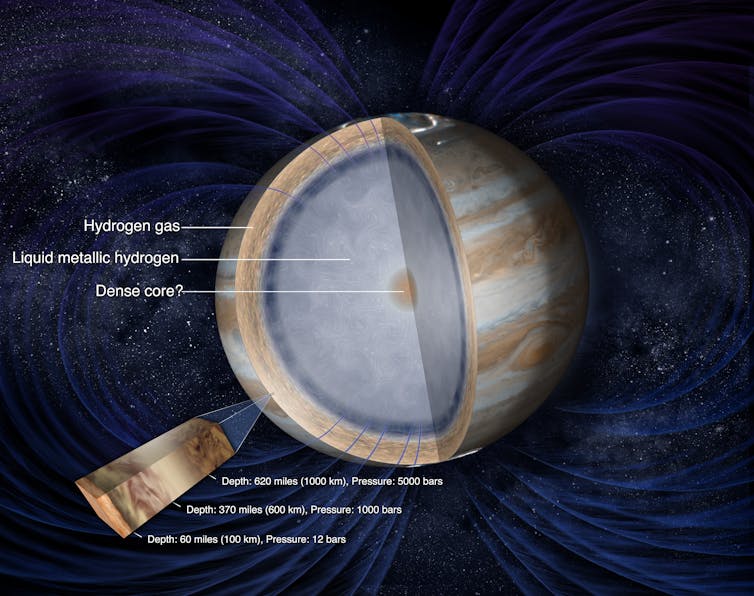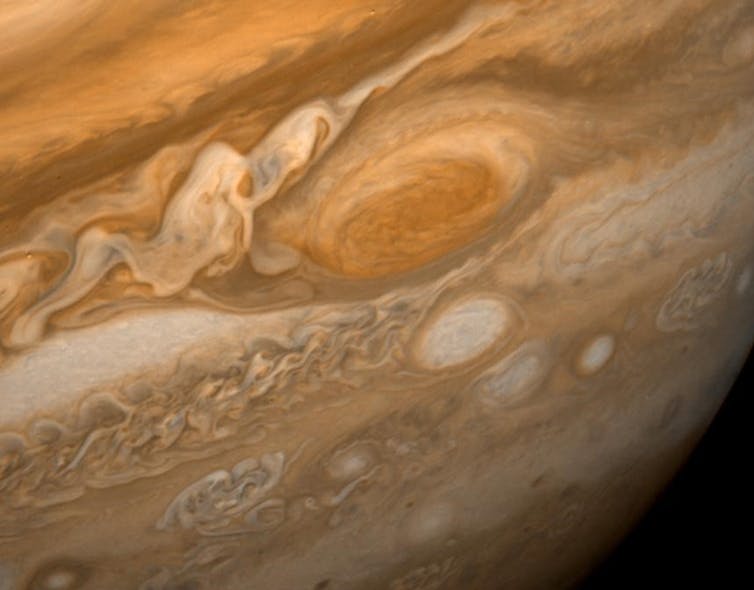Why does Jupiter appear like it has a floor – although it doesn’t have one? – Sejal, age 7, Bangalore, India
The planet Jupiter has no strong floor – no floor, just like the grass or grime you tread right here on Earth. There’s nothing to stroll on, and no place to land a spaceship.
However how can that be? If Jupiter doesn’t have a floor, what does it have? How can it maintain collectively?
Whilst a professor of physics who research all types of surprising phenomena, I notice the idea of a world with out a floor is troublesome to fathom. But a lot about Jupiter stays a thriller, at the same time as NASA’s robotic probe Juno begins its ninth yr orbiting this unusual planet.
Jupiter’s mass is two-and-a-half occasions that of all the opposite planets within the photo voltaic system mixed.
First, some info
Jupiter, the fifth planet from the Solar, is between Mars and Saturn. It’s the biggest planet within the photo voltaic system, large enough for greater than 1,000 Earths to suit inside, with room to spare.
Whereas the 4 interior planets of the photo voltaic system – Mercury, Venus, Earth and Mars – are all fabricated from strong, rocky materials, Jupiter is a fuel big with a composition much like the Solar; it’s a roiling, stormy, wildly turbulent ball of fuel. Some locations on Jupiter have winds of greater than 400 mph (about 640 kilometers per hour), about thrice quicker than a Class 5 hurricane on Earth.

A photograph of the southern hemisphere of Jupiter, taken by NASA’s Juno spacecraft in 2017.
NASA/JPL-Caltech/SwRI/MSSS/Gerald Eichstadt/Sean Doran
Looking for strong floor
Begin from the highest of Earth’s environment, go down about 60 miles (roughly 100 kilometers), and the air strain repeatedly will increase. Finally you hit Earth’s floor, both land or water.
Evaluate that with Jupiter: Begin close to the highest of its principally hydrogen and helium environment, and like on Earth, the strain will increase the deeper you go. However on Jupiter, the strain is immense.
Because the layers of fuel above you push down increasingly more, it’s like being on the backside of the ocean – however as an alternative of water, you’re surrounded by fuel. The strain turns into so intense that the human physique would implode; you’ll be squashed.
Go down 1,000 miles (1,600 kilometers), and the new, dense fuel begins to behave unusually. Finally, the fuel turns right into a type of liquid hydrogen, creating what could be considered the biggest ocean within the photo voltaic system, albeit an ocean with out water.
Go down one other 20,000 miles (about 32,000 kilometers), and the hydrogen turns into extra like flowing liquid metallic, a cloth so unique that solely not too long ago, and with nice issue, have scientists reproduced it within the laboratory. The atoms on this liquid metallic hydrogen are squeezed so tightly that its electrons are free to roam.
Needless to say these layer transitions are gradual, not abrupt; the transition from regular hydrogen fuel to liquid hydrogen after which to metallic hydrogen occurs slowly and easily. At no level is there a pointy boundary, strong materials or floor.

An illustration of Jupiter’s inside layers. One bar is roughly equal to the air strain at sea degree on Earth.
NASA/JPL-Caltech
Scary to the core
Finally, you’d attain the core of Jupiter. That is the central area of Jupiter’s inside, and to not be confused with a floor.
Scientists are nonetheless debating the precise nature of the core’s materials. Essentially the most favored mannequin: It’s not strong, like rock, however extra like a sizzling, dense and presumably metallic combination of liquid and strong.
The strain at Jupiter’s core is so immense that it could be like 100 million Earth atmospheres urgent down on you – or two Empire State buildings on prime of every sq. inch of your physique.
However strain wouldn’t be your solely downside. A spacecraft attempting to achieve Jupiter’s core can be melted by the intense warmth – 35,000 levels Fahrenheit (20,000 levels Celsius). That’s thrice hotter than the floor of the Solar.

A picture taken of Jupiter by Voyager 1. Be aware the Nice Purple Spot, a storm massive sufficient to carry three Earths.
NASA/JPL
Jupiter helps Earth
Jupiter is a bizarre and forbidding place. But when Jupiter weren’t round, it’s doable human beings won’t exist.
That’s as a result of Jupiter acts as a protect for the interior planets of the photo voltaic system, together with Earth. With its huge gravitational pull, Jupiter has altered the orbit of asteroids and comets for billions of years.
With out Jupiter’s intervention, a few of that house particles might have crashed into Earth; if one had been a cataclysmic collision, it might have brought on an extinction-level occasion. Simply have a look at what occurred to the dinosaurs.
Perhaps Jupiter gave an help to our existence, however the planet itself is awfully inhospitable to life – at the very least, life as we all know it.
The identical isn’t the case with a Jupiter moon, Europa, maybe our greatest likelihood to search out life elsewhere within the photo voltaic system.
NASA’s Europa Clipper, a robotic probe launching in October 2024, is scheduled to do about 50 fly-bys over that moon to check its huge underground ocean.
May one thing be dwelling in Europa’s water? Scientists received’t know for some time. Due to Jupiter’s distance from Earth, the probe received’t arrive till April 2030.
And since curiosity has no age restrict – adults, tell us what you’re questioning, too. We received’t be capable of reply each query, however we’ll do our greatest.